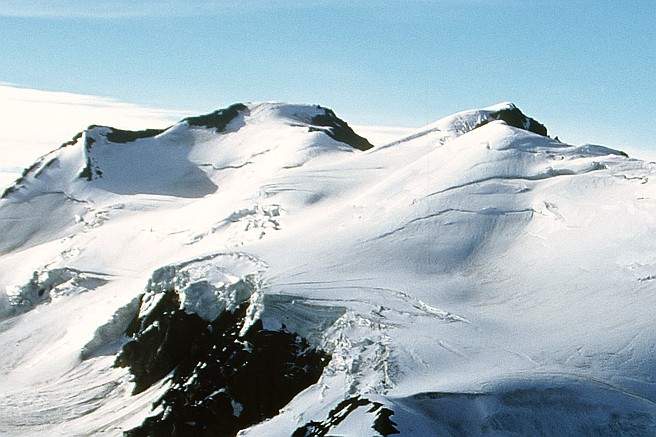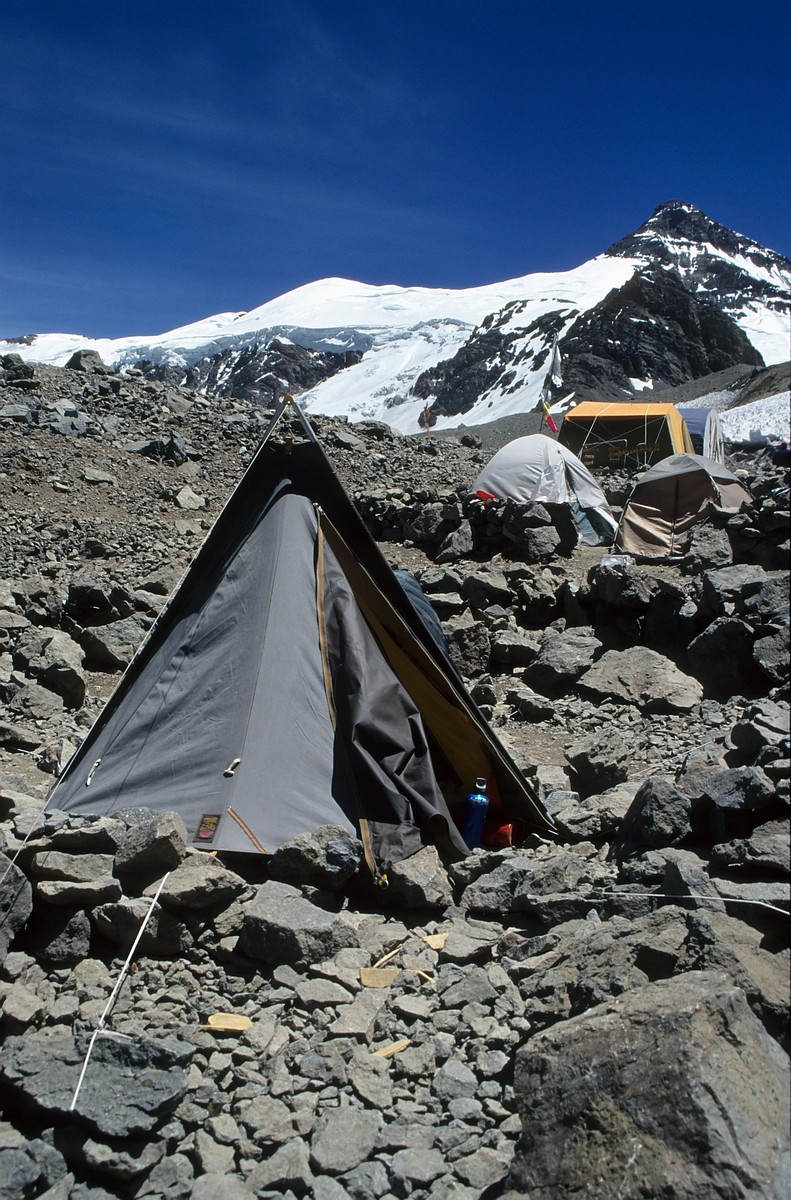Peering out of the tent at 9:16 on 13th January, everything looked very much as it had done the previous morning, and the morning before that : the conditions were clear, calm and cold; the scenery white, grey and blue. The Australians were already starting to pack food into their rucksacks, though without any great hurry – we had all day to climb eight hundred metres and come down again. I was just finishing breakfast when Tork headed off, saying he’d see me at Canada. Ten minutes later Tim set off, followed five minutes later by me. I was carrying ten days worth of food, some high altitude clothing that I wouldn’t need until later, my crampons, and a one litre fuel bottle. I wore my trainers, and left my boots in the tent. My intention was that the following morning I would leave my trainers in base camp for the duration, and use just my new plastic boots from then on.
I hopped over the stream, which was a slightly turbid meltwater stream from some penitentes filling the side valley above Plaza de Mulas. The first bit of the path went up through part of this area of penitentes, which was difficult with a wide rucksack, as the “cutting” wasn’t very wide. I squeezed through it, and was soon climbing the steep zigzags above basecamp. Thinking about how exhausted I had felt on arrival at Plaza de Mulas two days previously, I was relieved to find that I could now climb quite easily. This was partly because the rucksack was only half the weight, but mainly because of acclimatisation. We had been looking up at the zigzags from our tents with some trepidation the previous day, fearing that we would be gasping for breath and suffering every step, for the rest of the ascent.
I took it slowly, but soon noticed that I was gradually catching Tim up. I monitored the altimeter on my watch – I appeared to be ascending one hundred metres every fifteen minutes, which was excellent. After ascending half of the height gain to Canada Camp, I stopped for my mid-morning snack by a rocky outcrop in the middle of a huge steep boulder field. Despite the fact that the ascent was basically on loose rocks, it was nothing like as bad as it had looked from below. There were a lot of finer rocks and gravel mixed in, which made the slope a lot more stable, at least where the path zigzagged up. There were actually two paths – one stable path with zigzags for going up, and another one without zigzags, which had plenty of loose rocks that would hopefully make scree running possible on the way down.
Half an hour further up I caught up some of the Canadians, who were taking it very slowly as they had twice as far to go (this might sound illogical at sea level, but at 5000m it makes perfect sense). Shortly afterwards I branched rightwards away from the main path, crossing a small gully, to where I could see Tim heading up towards the flat top of a spur, that constituted Canada camp. The last part of the path ascended rather steeply, and once over the top I saw Tork sitting on a rock. The camp was smaller and vastly more exposed than I had expected, with room for no more than eight or ten tents – the flat area was only twenty metres by ten metres. There was a rocky outcrop on the west side which might offer certain tents a small amount of protection from winds directly from that direction, and to the east rose the rest of Aconcagua. However, any wind from a roughly northerly or roughly southerly direction would hit all the tents directly, with all its force. Then again it wasn’t all bad : what Canada Camp lacked in protection was made up for in uninterrupted views…
Tim had wandered further over to a similar ledge on the top of another spur about three hundred metres to the south, to see if it was any better. After a while he came back saying it was cleaner, but given that there was hardly any wind it was difficult to be sure whether it would be better protected or just as terrible. We climbed fifty metres further up the hillside above the ledge to make our cache. We left things in plastic sacks and piled rocks on the top; then we sat around for a short while to enjoy the view. I felt OK regarding the altitude – it was hard to believe I was two hundred metres higher than I had been on the summit of Tungurahua. Then we headed off downhill with Tim in the lead.
Loose stones on a steep mountainside are of course, horrible when going up, but can make for a fast way to descend (“scree running”) if they are small and plentiful enough. I couldn’t really scree-run in my trainers, but even so we lost height rapidly. Tork and I saw Tim arrive in Plaza de Mulas – he took nineteen minutes to descend what had taken two hours to ascend. We took just over thirty minutes, without hurrying. It was great to get back so early, knowing that we had done our work for the day, and could now just slob around again. I decided I had earned a cooked lunch, and decided to experiment with rehydrating some charqui (dried meat). It had tasted so nice dry that I couldn’t imagine it getting any less good if I threw the contents of a packet in with some rice that I was cooking. However the result was truly appalling – I was relieved that I hadn’t replaced more tinned fish with charqui. And of course it transpired that it was horsemeat not beef.
During the afternoon I managed to do something rather silly, by dropping the top of my Sigg water bottle in the fast flowing meltwater stream at Plaza de Mulas. This meant I only had the two litre water bag, which was no good for taking swigs from while I was walking. Luckily I was able to obtain an empty plastic 1.5 litre Coca Cola bottle from the first “fast-food” tent that we had tried. This actually increased my water storage capacity as the Sigg bottle had been less than a litre.
The sky started to look a little threatening, with high cloud and a ring round the sun. Thicker cloud came up from Chile and spilled over the frontier ridge. We also noticed the wind getting up a little, but the air temperature wasn’t dropping too much. Later on I wandered over to see Dan and Jim. They were mourning the death of their super hi-tech water filter, which had taken one gulp from the stream, gasped at the quantity of silt, choked, and promptly expired, never to pass another drop. Jim was busy melting snow on the MSR stove they had – he reckoned this was better than boiling the stream water (I had been treating the stream water with iodine drops, but apart from that just drinking it straight). Jim and Dan were planning to carry everything up to Canada in one go the following day, and were in the process of packing up what they were leaving at base camp. They said they had eighty plastic bags to give away (the bags they bought came in packs of one hundred), and I said I could use a few for rubbish and suchlike. I hadn’t been using the official rubbish bag, as it was far too big for the rubbish I had so far generated. Besides, it was far too useful as a groundsheet for the “porch” area of my tent.
Wandering round Plaza de Mulas I was now feeling quite well acclimatised, although I had woken up a couple of times the previous night and had had difficulty getting back to sleep . The Aussies said they had felt OK going up to Canada, but Tim also reported insomnia, and that he had been suffering headaches. Tork actually reported having heard gurgling in his lungs two days previously at Ibañez camp, which sounded very dodgy (gurgling lungs and coughing blood are symptoms of pulmonary oedema). Tork was still suffering headaches, but otherwise was now OK. Tim said the worst thing was that when he woke up in the middle of the night he was getting bored to tears – the previous night he had entertained himself by repeatedly counting his teabags. He couldn’t afford to waste torch batteries reading, and didn’t have any candles. I, on the other hand, had candles in great store, and I espied further possibilities for wheeling and dealing. Following his trades with Andrea, Tim had lots of high quality mashed potato – I had tried some and it was very good. I had an excess of candles due to the fact that the general store where the bus had stopped on the way up only sold them in packs of four. Tim was most enthusiastic about proposals for further trading and offered two of his sachets of mash (four days worth) for one candle. So the deal was sealed, and Tim was ecstatic at the prospect of several nights free from boredom, and I was delighted with the prospect of more mash to have at high altitude. It later became apparent that our little deals were very typical, and that Plaza de Mulas is quite a centre of commerce in terms of the amount of swapping of commodities and gear that goes on there.
We saw that the Canadians had got back, and had a chat with two of the people in the group who we knew. They were, they said, all pretty tired : it was a very long way up to Nidos. We were glad we were doing it in two stages.
Then it was once more time for Andrea’s wonderful cheeseburgers, and off to her tent we trotted, with rumbling stomachs. Again she came up with the goods, though it appeared that our previous visits had exhausted her supply of ketchup. However, there was still plenty of mustard and salsa golf (ketchup mixed with mayonnaise) so we were OK. Then she offered us tea again, with half a dozen teabags of different flavours from which to choose. We took our time and discussed plans for the next day. We were a little unsure about where to cache the things that we wanted to leave at Plaza de Mulas. However, a word in Andrea’s ear about the problem, and it was a problem solved : she would be delighted to look after our stuff for us.
The wind was gusting quite viciously as we returned to our tents. It looked as if we were in for a noisy night.



